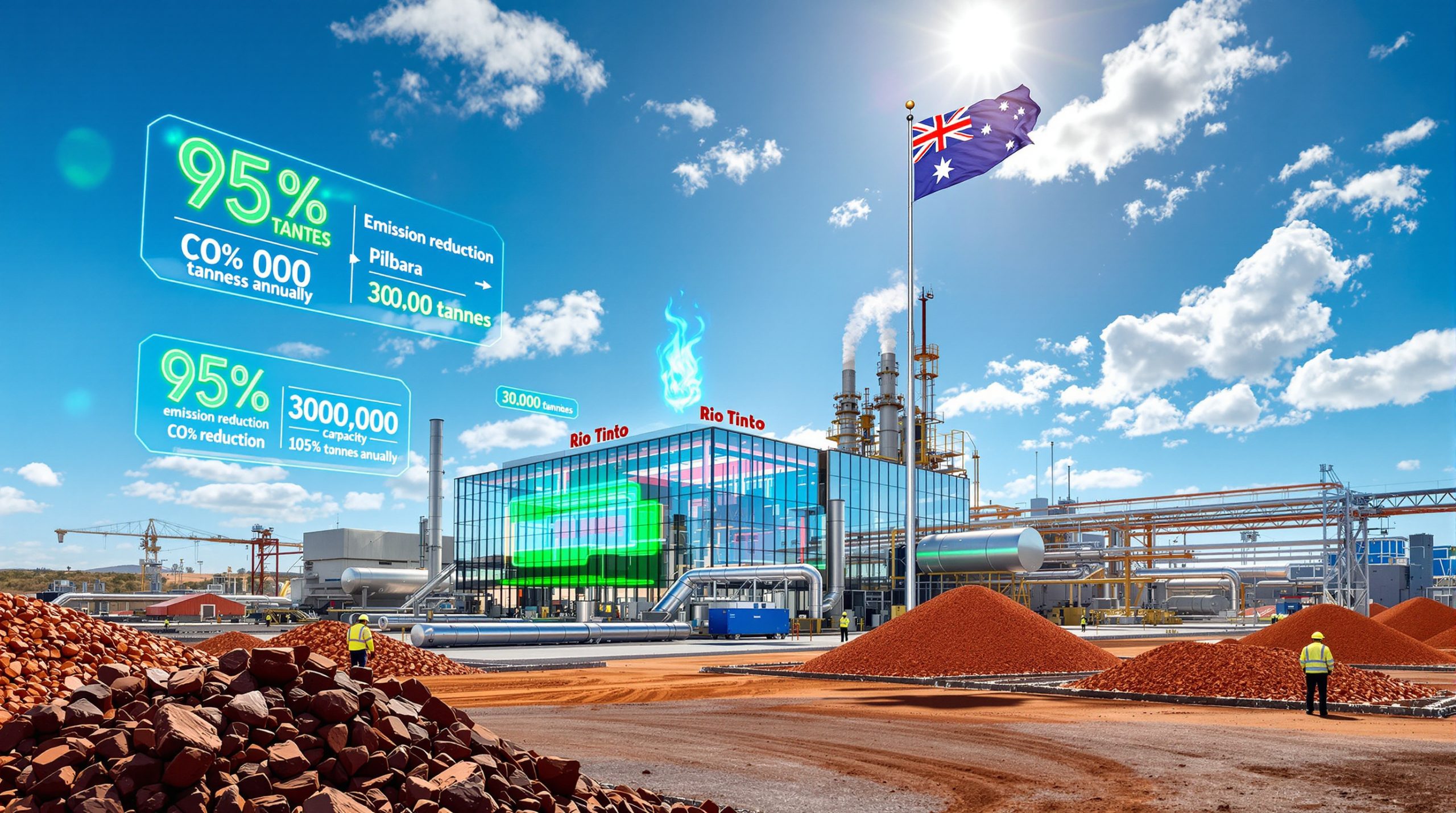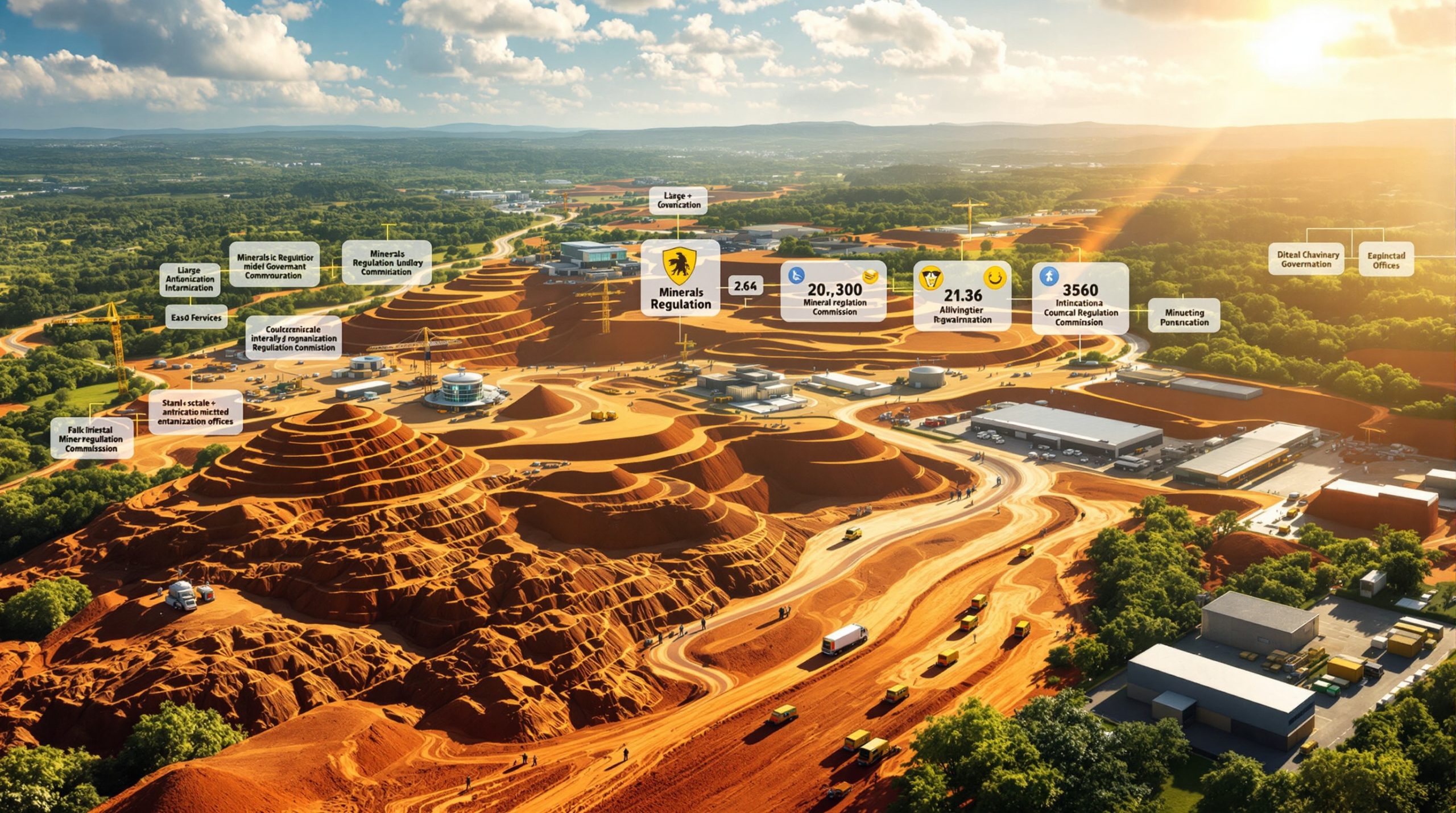Rio Tinto's Strategic Pivot Transforms Low-Emissions Steel Production Landscape
Rio Tinto has fundamentally restructured its approach to sustainable steelmaking through a strategic partnership with Australian technology firm Calix to develop the Zesty™ Green Iron demonstration facility, while simultaneously placing its BioIron project on indefinite hold. This Rio Tinto low-emissions steel pilot represents a calculated shift toward hydrogen-based reduction technologies and electric heating systems, positioning the mining giant at the forefront of steel industry decarbonisation efforts.
The A$35 million investment in combined funding and technical support demonstrates Rio Tinto's commitment to establishing viable pathways for Pilbara iron ore within the evolving global steel production ecosystem. The Zesty™ demonstration plant, designed for 30,000 tonnes annual capacity of hydrogen direct-reduced iron production, leverages existing Kwinana infrastructure whilst advancing cutting-edge reduction chemistry.
Understanding Rio Tinto's New Low-Emissions Steel Strategy
The partnership between Rio Tinto and Calix represents more than a simple technology demonstration. It embodies a comprehensive strategic realignment toward hydrogen-based iron reduction processes that could fundamentally alter how the steel industry approaches environmental sustainability without compromising operational efficiency.
The Zesty™ Green Iron demonstration facility employs electric heating combined with hydrogen reduction processes, creating a technological pathway that promises near-zero emissions during the iron production phase. This approach differs substantially from traditional blast furnace operations, which rely heavily on carbon-intensive coke and coal consumption.
Key components of this strategic initiative include:
- Financial commitment: A$35 million in combined funding and technical support from Rio Tinto
- Production capacity: 30,000 tonnes annually of hydrogen direct-reduced iron or hot-briquetted iron
- Technology focus: Electric heating integrated with hydrogen reduction chemistry
- Location advantage: Kwinana site positioning with existing utility infrastructure and port access
- Licensing rights: Non-exclusive global and perpetual licence for commercial deployment
The Calix partnership also secures separate Australian Renewable Energy Agency (ARENA) funding of up to A$44.9 million, subject to matched funding requirements, creating a robust financial foundation for technology development and validation.
Technical Assessment Behind the BioIron Project Suspension
Rio Tinto's decision to pause further BioIron development stemmed from comprehensive technical evaluations that revealed significant performance limitations requiring extensive additional research phases before commercial viability could be established. The company's assessment identified critical areas where the current furnace design necessitated substantial improvements.
The BioIron technology, developed over the past decade by Rio Tinto's steel decarbonisation team, utilised raw biomass materials including wheat straw, bagasse, and rice stalks as reducing agents. This approach consumed approximately one-third of the electricity required by hydrogen-based alternatives, representing a significant energy efficiency advantage that ultimately proved insufficient to overcome identified technical obstacles.
Furthermore, the technical challenges that led to project suspension included performance optimisation requirements, risk mitigation needs, and resource allocation priorities. Rio Tinto's assessment showed that "more work was needed to minimise technical risks and improve performance, though the company remained committed to the long-term potential of the technology."
The technical challenges that led to project suspension included:
- Performance optimisation: Current furnace designs requiring substantial engineering improvements
- Risk mitigation: Technical uncertainties demanding resolution before commercial deployment
- Resource allocation: Strategic focus shifted toward more promising technological pathways
- Development timeline: Extended research phases conflicting with commercial deployment objectives
Despite the pause, Rio Tinto continues collaborative research with the University of Nottingham and Metso, indicating that biomass-based reduction remains a viable long-term technological option pending resolution of current technical limitations.
Comparative Analysis of Zesty™ Technology Against Traditional Methods
The Calix Zesty™ process represents a revolutionary departure from conventional steelmaking through its integration of renewable energy sources and hydrogen reduction chemistry. This technological approach offers substantial advantages across multiple operational parameters compared to traditional blast furnace operations.
| Parameter | Traditional Blast Furnace | Zesty™ Process | Improvement Potential |
|---|---|---|---|
| Carbon Emissions | High CO₂ intensity from coke combustion | Near-zero emissions with green hydrogen | Up to 95% reduction possible |
| Energy Source | Coal and coke dependency | Electric heating plus hydrogen | 100% renewable energy potential |
| Ore Compatibility | Limited to high-grade materials | Pilbara ores including lower grades | Enhanced resource utilisation |
| Scalability | Large-scale infrastructure requirements | Modular design flexibility | Incremental capacity expansion |
| Operating Flexibility | Continuous high-temperature operation | Variable production scheduling | Demand-responsive operations |
The technological advantages extend beyond environmental performance to encompass operational flexibility and resource optimisation. The modular design architecture allows for capacity expansion without requiring complete facility reconstruction, while compatibility with various iron ore grades from Pilbara operations maximises resource utilisation efficiency.
In addition, the Zesty™ technology's integration capabilities with existing port and utility infrastructure at the Kwinana site provide additional competitive advantages, reducing capital deployment requirements and accelerating commercial deployment timelines.
Strategic Importance of the NeoSmelt Collaboration Framework
Rio Tinto's parallel involvement in the NeoSmelt project alongside industry partners creates a comprehensive testing environment for multiple low-emissions pathways, reducing technological risk through diversified development approaches. However, this Rio Tinto low-emissions steel pilot project demonstrates the company's commitment to multiple technological pathways.
The NeoSmelt project specifications include:
- Annual capacity: 30,000-40,000 tonnes of molten iron production capability
- Technology pathway: Direct Reduced Iron-Electric Smelting Furnace (DRI-ESF) methodology
- Emission reduction potential: Up to 80% CO₂ intensity decrease compared to conventional operations
- Transition strategy: Initial natural gas utilisation progressing to zero-emission hydrogen deployment
- Geographic coordination: Location near Kwinana Zesty™ site enabling operational synergies
This multi-project approach enables Rio Tinto to evaluate different technological pathways simultaneously whilst sharing infrastructure costs and technical expertise across development initiatives. Consequently, the staged energy transition from natural gas to hydrogen reflects pragmatic recognition of current hydrogen supply infrastructure limitations whilst establishing pathways toward complete decarbonisation.
Optimising Pilbara Iron Ore Assets for Future Steel Production
The strategic focus on Pilbara ore compatibility ensures Rio Tinto's resource base remains central to the evolving global steel industry landscape. Matthew Holcz, Chief Executive of Rio Tinto Iron Ore, emphasised that the partnership would help progress a potential pathway for Pilbara ores in low-emissions steelmaking applications.
Benefits for Pilbara ore utilisation include:
- Grade flexibility: Lower-grade materials becoming economically viable through processing efficiency improvements
- Supply chain optimisation: Direct pathways from mining operations to low-emissions steel production
- Market positioning: Enhanced value proposition for Australian iron ore in global export markets
- Resource maximisation: Expanded economically viable ore reserves through processing technology advancement
Rio Tinto has committed to supply up to 10,000 tonnes of Pilbara ore for commissioning and initial testing phases, demonstrating confidence in technical compatibility and operational viability. This arrangement also provides valuable data on supply chain logistics and quality consistency requirements for commercial-scale operations.
Economic Transformation Implications for Global Steel Markets
The transition to low-emissions steel production creates substantial economic opportunities whilst addressing increasingly stringent environmental requirements across automotive, construction, and manufacturing industries. For instance, this aligns with broader mining industry trends toward sustainability and technological innovation.
The investment landscape demonstrates significant commitment from multiple stakeholders:
- Rio Tinto contribution: A$35 million in funding and technical support
- ARENA backing: A$44.9 million grant through Calix partnership
- Industry collaboration: Shared risk distribution across major industry players
- Technology licensing: Non-exclusive global rights for commercial deployment and sub-licensing opportunities
Market transformation potential extends across multiple dimensions, including supply chain decarbonisation, export competitiveness, employment creation, and technology leadership. These developments complement Australia's position in global Australian resource exports.
The non-exclusive global and perpetual licence structure enables Rio Tinto to commercialise Zesty™ technology across multiple jurisdictions whilst maintaining rights to sub-licence to affiliates and customers, creating potential licensing revenue streams beyond direct operational benefits.
Development Timeline and Critical Implementation Milestones
The project development pathway includes clearly defined phases with specific decision points and performance targets designed to minimise investment risk whilst accelerating commercial deployment.
Project Development Schedule:
- 2025-2026: Joint Development Agreement implementation and detailed engineering phases
- 2026: Final investment decision (FID) expected for Zesty™ demonstration plant
- 2027-2028: Construction and commissioning phases following FID approval
- 2029: Initial production commencement with 10,000 tonnes of Pilbara ore testing
- 2030+: Commercial scalability assessment and potential expansion planning
Under the Joint Development Agreement framework, Rio Tinto provides engineering and technical services to support project advancement toward the 2026 final investment decision milestone. This structured approach enables systematic risk evaluation whilst maintaining development momentum.
The 2029 testing phase with 10,000 tonnes of Pilbara ore represents a critical validation milestone, providing operational data necessary for commercial-scale deployment decisions and potential technology licensing arrangements.
What Technical Challenges Must Be Resolved?
Several technical and commercial obstacles require systematic resolution to ensure project viability and scalability across diverse operational environments.
Technical Considerations:
- Hydrogen supply infrastructure: Reliable green hydrogen availability at commercial scale requiring coordination with renewable energy developers
- Energy grid integration: Renewable electricity supply stability and load management requirements
- Process optimisation: Continuous improvement of reduction efficiency and operational reliability
- Equipment durability: Long-term performance validation under commercial operating conditions
Commercial Factors:
- Cost competitiveness: Achieving economic parity with traditional steelmaking whilst maintaining environmental advantages
- Market acceptance: Steel industry adoption of new production methods across diverse application requirements
- Regulatory framework evolution: Carbon pricing mechanisms and environmental standards development
- Customer relationship development: Downstream steel producer engagement and technical validation
Global Steel Decarbonisation Context and Competitive Positioning
Rio Tinto's hydrogen-based approach aligns with international decarbonisation trends whilst leveraging Australia's unique resource advantages and renewable energy potential. This reflects broader renewable energy transformations across the mining sector.
The company's strategy positions Australian iron ore assets advantageously within evolving global steel production infrastructure. International comparison reveals diverse technological approaches across European initiatives, Asian developments, North American projects, and Australian advantages.
- European initiatives: Hydrogen-based reduction projects similar to Zesty™ methodology across multiple steel producers
- Asian developments: Electric arc furnace capacity expansion and efficiency improvements
- North American projects: Carbon capture and storage integration with traditional blast furnace operations
- Australian advantages: Abundant renewable energy resources and high-quality iron ore integration opportunities
The geographic proximity of the Kwinana demonstration facility to existing port infrastructure enables efficient export logistics for low-emissions iron products, providing competitive advantages in serving international markets demanding sustainable steel inputs.
How Does This Compare to South Australian Initiatives?
Whilst Rio Tinto advances its Zesty™ technology in Western Australia, South Australia green iron production initiatives demonstrate Australia's national commitment to sustainable steelmaking. These parallel developments create synergistic opportunities for technology sharing and market expansion.
Long-term Strategic Positioning and Industry Leadership
Rio Tinto's strategic pivot toward hydrogen-based technologies establishes the company as a technology leader in sustainable mining and metals production whilst preserving competitive advantages in global iron ore markets. Moreover, this reflects broader trends in mining electrification and decarbonisation across the industry.
Strategic positioning benefits include:
- Technology leadership: First-mover advantages in low-emissions iron production methodologies
- Enhanced customer relationships: Strengthened partnerships with environmentally conscious steel producers
- Asset optimisation: Maximised value extraction from Pilbara ore reserves through processing flexibility
- Market differentiation: Premium pricing potential for certified low-emissions iron products
The successful development of both Zesty™ and NeoSmelt pilot projects could establish new industry standards for sustainable steelmaking, creating pathways for widespread adoption of hydrogen-based reduction technologies across global steel production infrastructure.
Future Implications for Sustainable Steel Production
Rio Tinto's strategic transformation signals broader industry evolution toward environmental responsibility whilst maintaining production efficiency and economic competitiveness. The integration of Australian iron ore resources with advanced reduction technologies demonstrates how traditional mining companies can adapt to meet emerging sustainability requirements.
The demonstration projects' success could accelerate global adoption of hydrogen-based steelmaking technologies, potentially transforming how the industry approaches carbon intensity reduction. Furthermore, this evolution extends beyond environmental compliance to encompass competitive positioning in increasingly carbon-conscious global markets.
Disclaimer: This article contains forward-looking statements regarding technology development, production targets, and commercial deployment timelines. Actual results may vary based on technical performance, market conditions, regulatory changes, and other factors beyond the companies' control. Investment and operational decisions should consider comprehensive risk assessments and current market conditions.
The successful execution of this Rio Tinto low-emissions steel pilot could establish Australia as a global leader in sustainable metallurgy whilst creating new economic opportunities across the minerals-to-metals value chain. The technology's compatibility with Pilbara ore grades ensures continued relevance of Australian resource assets in the evolving global steel production landscape.
Looking for Opportunities in Sustainable Steel Production Technologies?
Rio Tinto's strategic pivot to hydrogen-based steel production highlights the rapidly evolving landscape of sustainable metallurgy investments across the ASX. Discovery Alert's proprietary Discovery IQ model delivers real-time alerts on significant mineral and technology discoveries in sectors including green steel, renewable energy, and sustainable mining operations, ensuring subscribers identify actionable opportunities ahead of the broader market. Begin your 30-day free trial today to position yourself at the forefront of Australia's green industrial transformation.




